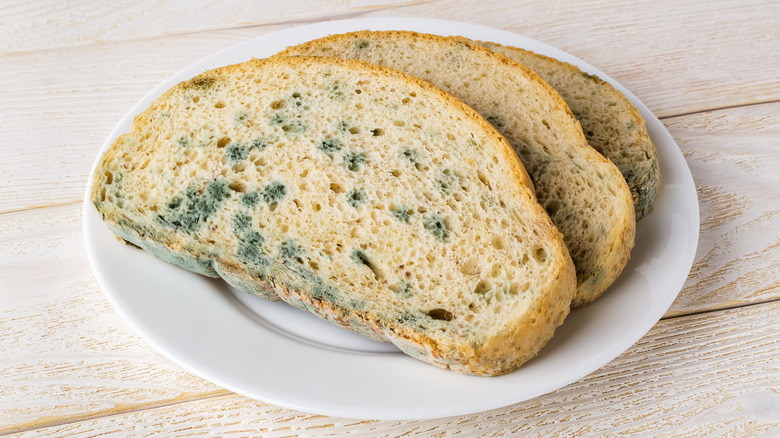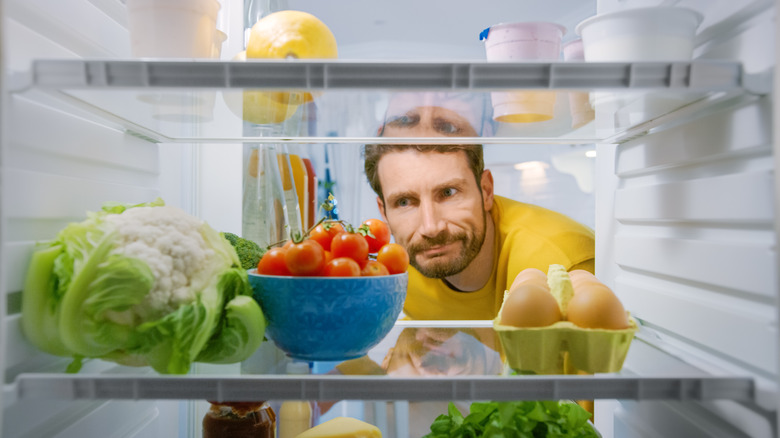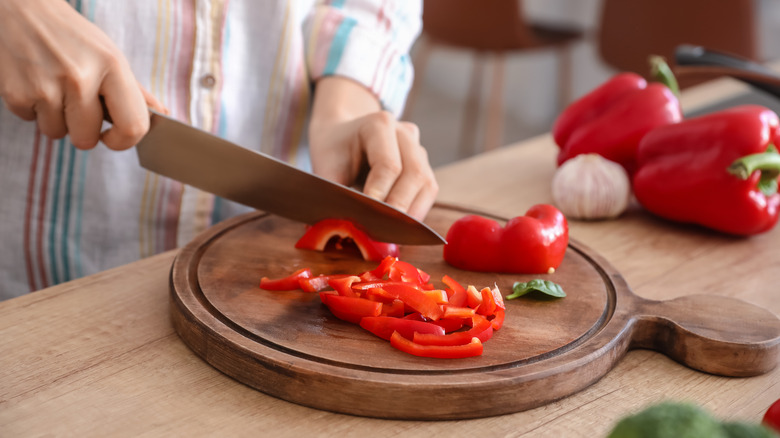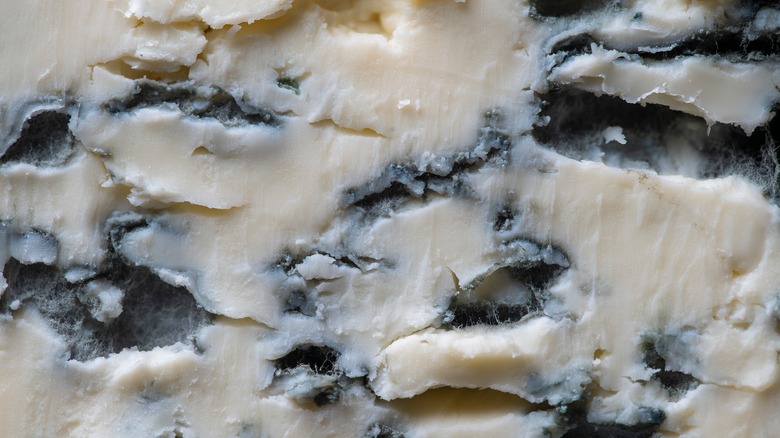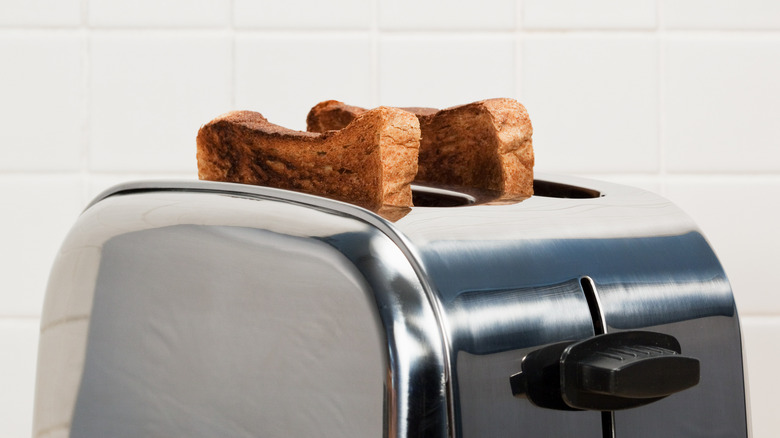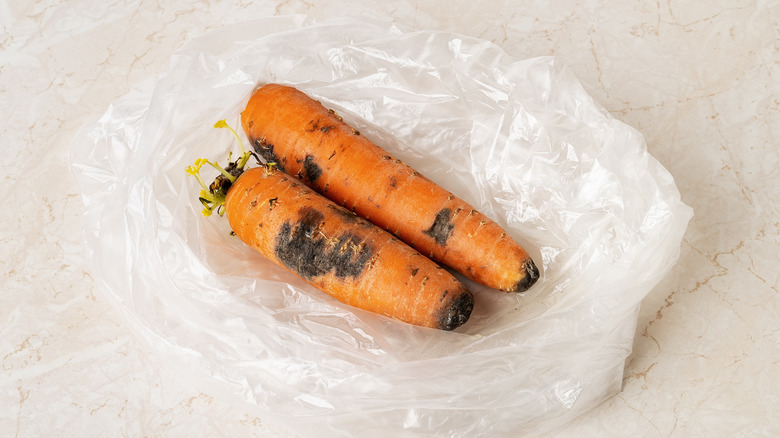What Happens When You Eat Mold By Accident
Have you ever grabbed a loaf of bread, made a sandwich, and then discovered (while eating it) that the bread was moldy? Well, you're not alone, but that probably doesn't make you feel any better. It smells bad and it looks disgusting, so it's natural to wonder if there are any ill health effects that come from accidentally eating mold.
Mold is tiny fungi and it isn't exclusive to bread or baked goods — it can distressingly show up on just about anything, such as the fresh fruits and vegetables you forgot about, that package of sliced turkey you found in the back of your fridge the other day that you bought last February, or your leftovers from two weeks ago.
Some mold is obvious and apparent, but according to the USDA, it doesn't always just show up on the surface of foods, and it's not always the blue-green color you're probably picturing in your head right now. Mold can be quite subtle, and it can also look like some harmless white fuzz on your food, it's still mold, though, and there's likely to be even more mold rooted deep inside your meal that you don't see until it's too late.
If you've eaten a small amount of mold, you'll probably be fine
So, you've eaten half of your hot dog and that last bite of the bun was moldy. Of course, you stop eating it and possibly spit out what's left, but what really happens when you ingest this off-putting fungus?
The good news is that it's usually immediately apparent that you've taken a bite of something bad, so you stop eating it ASAP. Ingesting a small amount of mold isn't likely to cause you any harm. However, mold itself can trigger an allergic reaction in those who are susceptible, and certain molds produce poisonous substances (mycotoxins) that can make you sick. If the mold isn't toxic, you'll probably just have a bad taste in your mouth. When you eat a bite of toxic mold, though, effects can vary. Symptoms can range from loss of appetite and loss of energy to serious illness. In some cases, ingesting toxic mold can be fatal.
If your food is moldy, discard it within a plastic bag directly into your trash can. Resist the urge to sniff it because that can cause breathing issues (also, it's smelly). Clean the area where you found your moldy food thoroughly. And if you experience any symptoms, even mild ones, it's a good idea to get checked out.
Can you salvage moldy produce and meats?
The USDA does have a handy list that outlines whether or not you can simply chop off the moldy part of your food and safely consume the rest instead of wasting what looks like "perfectly good bread." Here's a breakdown of what can be salvaged versus what you need to completely discard.
Firm fruits and vegetables, like cabbage, bell peppers, and carrots, can be preserved if you find mold. Their dense structure means that mold has a hard time penetrating further into the food. Cut at least 1 inch around and below the mold spot, and don't pull your knife through the mold as it can contaminate everything else.
Hard salami and dry-cured country hams can also be used if mold is present. It's common for these products to have surface mold when purchased — just scrub the mold off the surface and it's fine. The same goes for hard cheeses where visible mold is not part of the production process. For softer cheeses and other foods, though, the news isn't as good.
What to do if you find mold on soft cheeses and other foods
Cheeses that are made with mold as part of the manufacturing process can be salvaged, but only if the cheese is hard, such as Gorgonzola or Stilton (keep that 1-inch margin in mind, cut it off, and you'll be fine). Soft cheeses, though, such as Brie or Camembert, must be discarded, as the mold can spread to other parts of the food.
For everything else, including that entire loaf of bread you just bought before you noticed a spot of mold at the very end, you have to throw the whole thing away. Mold can spread through porous foods, such as bread, and foods with high moisture content, such as soft fruits and veggies, yogurt, sour cream, jams and jellies, luncheon meats, hot dogs, bacon, and basically all cooked leftovers, which can be contaminated below the surface.
If you're not sure, though, just chuck it in the bin, because the old adage, "When in doubt, throw it out!" is sound advice.
Will cooking the food kill the mold?
Say you've got half a loaf of Wonder bread left in your cupboard, and when you pull it out to make toast, you notice that the bread is growing mold. Although some of us may have an initial reaction of disgust (and promptly throw the bread away), some of us may wonder if giving the bread a good couple of minutes in the toaster will kill the mold, leaving the bread safe to eat.
However, this isn't exactly the case. According to Mold Busters, your toaster has to reach 160 degrees Fahrenheit in order to even start killing off mold spores. While you'll likely be toasting around 350, some molds require much higher temperatures. Furthermore, the amount of time it would take to completely kill the mold could also render your bread a charred mess, so it's not really feasible.
Even if you were able to cook your bread at a high enough temperature long enough to kill the mold, there's still the issue of the mycotoxins contained in mold spores. These toxins, per the Tokyo Food Safety Information Center, "cannot be completely destroyed" through typical cooking temperatures and times. As such, you definitely shouldn't eat moldy food, whether it's been toasted, fried, or boiled.
How to prevent mold from growing on your food
While there's no entirely foolproof way to prevent mold growth on your food, you can take several different steps to at least minimize the risk. As you might expect, most mold-prevention tactics have to do with proper storage and timely usage.
According to the U.S. Department of Agriculture, you should keep perishable items in the fridge as much as possible. Products that can't be sufficiently resealed — like cans, bags, takeout containers, etcetera — should be swapped out for clean, airtight containers or plastic wrap. On a similar note, leftovers should not be kept in the fridge for longer than a few days. Essentially, the longer your food is exposed to air or stored in the fridge, the more likely it is to grow mold.
That being said, we're all human, and mistakes happen. Depending on the type of mold on your food, food poisoning symptoms may kick in anywhere from 30 minutes to a few days after consumption, per the CDC. If you suspect you have food poisoning, do not try to make yourself throw up, and instead contact your doctor, stay hydrated, and get some rest while your body recovers.
